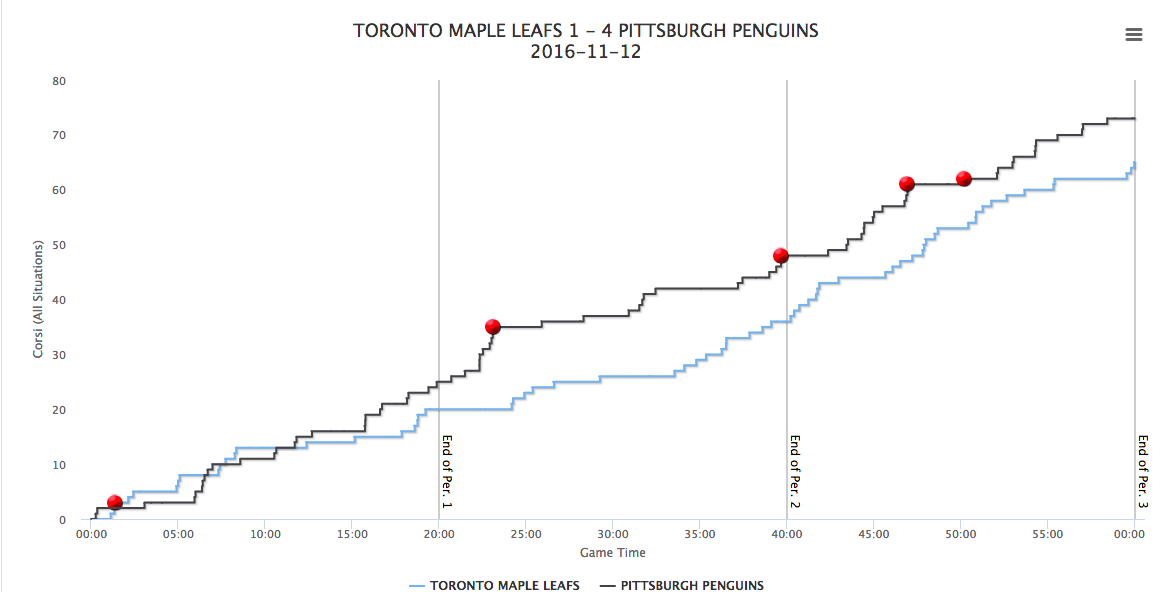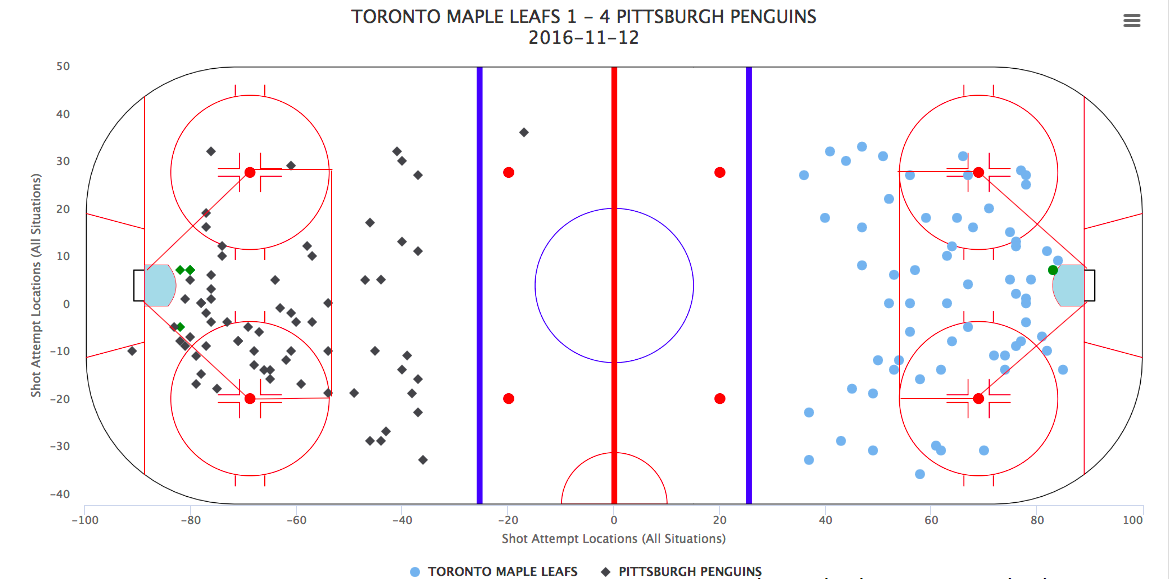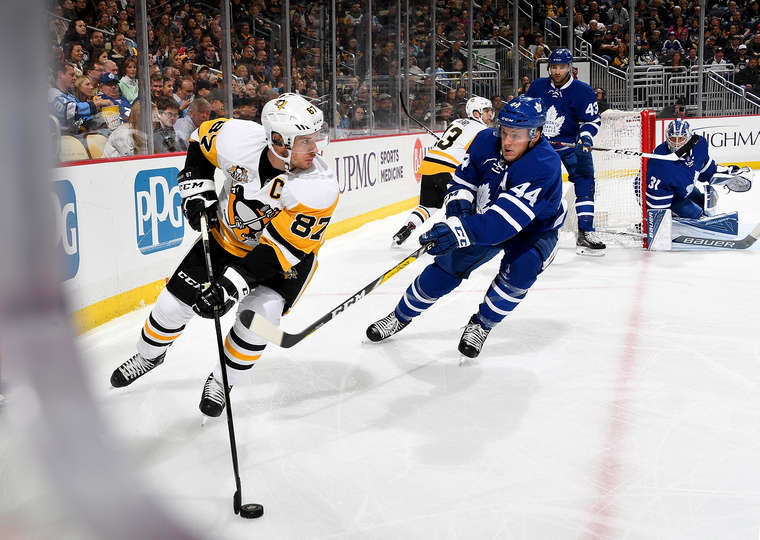For a Mike Babcock-coached team — with his history of tight, stifling, defensive hockey — the Maple Leafs’ style of play may come as a surprise early in the 2016-17 season.
The Leafs have seemingly strayed from a defensive system that was, for the most part, reliable, consistent and allowed them to transition from defensive zone coverage to a breakout relatively simply and easily. What their current own-zone play resembles is something most Maple Leafs fans will no doubt recoil in horror at the mere mention of — “The Swarm”.
There are a lot of teams that deploy “The Swarm” — or more accurately, an adapted version of “The Swarm” — where the goal is to create outnumbered situations in the defensive zone. The logical assumption is that there is a lack of trust on Mike Babcock’s part due to the number of rookies in the lineup. What we have seen, some 15 games in the season, is a system that more closely resembles the way Randy Carlyle had his Leafs teams defending; four and sometimes five players below the hashmarks, and, at times, four-on-one situations in the corner and/or on the halfwall.
While there were situations last season where the Leafs would collapse back to the net or overload one side of the ice, they fanned out and covered more of the ice at the same time. Right now, the Maple Leafs are leaking shots against (34.3, 30th in the NHL). It may look like it’s the whole team that is causing it, but really it’s an over-reliance on the wingers collapsing back towards the net that leaves the points wide open. When the Leafs don’t have the puck, opposing centermen and forwards are able to cycle the puck back to the point, where defensemen are funneling shots towards the net for tips, rebounds and second chance opportunities (or simply rushing the puck in from the blueline with the newly afforded space available to create offense).
Another unintended consequence – and we did see this non-stop under Carlyle — is that the opposition defense is able to exploit the large gaps between the Leafs’ defence and the forwards receiving outlet passes on the breakout. The opposition D is often seen pinching heavily, attacking with speed on a stationary forward, and forcing repeated turnovers on the breakout.
Here is a short clip of the Leafs getting worked North/South from low to high, with their wingers quite low in the offensive zone, as well as a failed breakout due to a pinching Penguins defenceman.
In late October, Jack Han of Habs Eyes on the Prize did a great job of outlining the Leafs’ “Total Hockey” system in which all five players are involved in the offence.
New #1MinuteTactics: Offensive intentions & "Total Hockey" approach make @MapleLeafs THE team to watch in the NHL #tmltalk pic.twitter.com/NHaHePTANu
— Jack Han (@ml_han) October 29, 2016
The video claims that the Leafs are the only team in the league to employ “Total Hockey”, but this is a system, offensively, that has been adapted from — you guessed it — the Pittsburgh Penguins (and the Tampa Bay Lightning). Combine the Leafs’ adapted “swarm” with heavy collapsing from the wingers and the extremely active Penguins defencemen pinching down the walls — drifting in from the point looking for loose pucks, turnovers, or short bump passes off the wall — and it’s a recipe for high shots against totals (especially in a back-to-back game, on the road, against the Pittsburgh Penguins).
The main idea behind the swarm is to protect the critical areas of the ice; some refer to it as “homeplate,” while others refer to it as “the house.” (Draw a line from the post to the face-off dot, a line from the face-off dot to the top of the face-off circle, a line from the top of the face-off circle to the top of the opposite faceoff circle, a line down to the faceoff dot, and a line back to the opposing post. It will resemble a house or the home plate seen on a baseball diamond, as shown below in the shot location chart). As the theory goes, if you can protect home plate, you can control the scoring chances against with more efficacy.
While this may look disorganized at times, the thinking behind it is that it will alleviate some of the defensive burden on the young Leaf wingers. However, it does give more responsibility to them in terms of stopping and starting, having to collapse below the hashmarks, and rush back up to the point — essentially, covering more ice quickly. When the puck gets cycled back to the point successfully, it is on the wingers to attack the points without overcommitting. Often times, they’re a step too slow and the defense is able to get shot through with ease.
It will be an interesting storyline to follow as the season progresses: When — or if — the Leafs return to the classic Babcock defensive zone play with tight five-man units that smother all areas of the ice and double as passing “safety valves” when there is a change in possession, giving the player charged with making the first pass between two and four different options for a short first pass to begin the breakout.
Notes
– Nazem Kadri and his line felt a step slow to loose pucks all night and chased the game quite a bit. The Crosby line + Letang exploited the Leafs collapsing low better than the other lines thanks to their sheer ability to cover ice quickly, as well as a relentless determination on loose pucks that is hard to match shift-after-shift.
– Connor Brown looks like he’ll be a good match on the Matthews line. He can handle the puck, but he can play off the puck just as well and will be more than happy to simply find Matthews as much as possible.
– Auston Matthews looks much better on a line that is “his own” (with two complementary players in Zach Hyman fetching pucks, and Brown giving and going as well as being a good “digger”). It is a much different element up front when the three kids are on different lines and the other players on the lines know to get the puck to them. Matthews had some monster shifts showing his hands in traffic and his strength/power in his first step explosion (eg: pushing the puck forward off the draw, slipping by the center, and getting a shot off).
– William Nylander has had, probably, his worst three games as a Leaf this season. He was part of the Komarov-Kadri line that got dominated pretty handily versus the Crosby line. The last two games are the first time this season that he’s spent significant time off of Matthews’ line. They were getting pillow-soft starts, often in the offensive zone and with favourable matchups against third and fourth lines. Nylander always wants the puck on his stick; playing with Kadri, who also wants to have the puck on his stick at all times, means it will take a while for the pair to find each other’s sweet spots. The tempo and timing of their passes always seemed to be off by half a measure; they are sometimes trimming off speed to corral a puck or a pass they were expecting a bit earlier. Their speed as a line should increase significantly once they know where each other wants the puck. That adjustment, combined with some clumsy breakouts, made for some tiring shifts where they constantly chased the play in this game.
– Morgan Rielly led the team in TOI and tied for the lead in shots on goal with Kadri and Bozak (5). He was -3 on the night, but played well enough, despite being on for some horrid shifts against the Crosby line where the Leafs, as a 5-man unit, were able to do little except collapse back to the “house” and try to limit the scoring chances. He finished a 40CF% and was sucking dirty pond water while Crosby was on the ice.
– Nikita Zaitsev played well but wore goat horns on the Crosby goal. While he did a good job to tie him up and get body position on him, it’s Sidney Crosby, so he was able to spin off the check and get his stick on the ice at just the right moment for a re-direct into the net. Leave him open for a fraction of a second and you’ll pay.
– In recent pressers, Babcock has been alluding to some early struggles by a few unnamed defencemen, suggesting a couple of them are not living up to their potential. Two presumed candidates: Jake Gardiner and Martin Marincin. With a big bump in TOI for Gardiner in this game, it appears he was challenged from the coaching staff and fed a healthy dose of minutes to see how he would respond. He was even on the night with no goals against while he was on the ice and a 55 CF%.
– Matt Hunwick had a really good first game back from injury, especially considering he was coming back from a pretty long layoff. He put three shots on goal in the first period alone and led the team in possession metrics with a 59.09 CF% in second pairing usage (20:30TOI) alongside Martin Marincin. He also assisted on the Zach Hyman goal.
All Situations Shot Attempts

Shot Location Chart




![Sheldon Keefe on the Maple Leafs’ struggling power play: “[We’ve scored] one out of 11 high-danger chances in tight to the net… We have been in those spots and haven’t converted” Sheldon Keefe, playoff press conference](https://mapleleafshotstove.com/wp-content/uploads/2024/04/keefe-pc-game-3-218x150.jpg)

![Jim Montgomery Post Game, Bruins 4 vs. Leafs 2: “[Marchand] still manages to get under people’s skin, yet he doesn’t cross the line” Jim Montgomery, Boston Bruins post game](https://mapleleafshotstove.com/wp-content/uploads/2024/04/jim-monty-pg-to-218x150.jpg)


























![Sheldon Keefe on the Maple Leafs’ struggling power play: “[We’ve scored] one out of 11 high-danger chances in tight to the net… We have been in those spots and haven’t converted” Sheldon Keefe, playoff press conference](https://mapleleafshotstove.com/wp-content/uploads/2024/04/keefe-pc-game-3-100x70.jpg)



![Jim Montgomery Post Game, Bruins 4 vs. Leafs 2: “[Marchand] still manages to get under people’s skin, yet he doesn’t cross the line” Jim Montgomery, Boston Bruins post game](https://mapleleafshotstove.com/wp-content/uploads/2024/04/jim-monty-pg-to-100x70.jpg)
